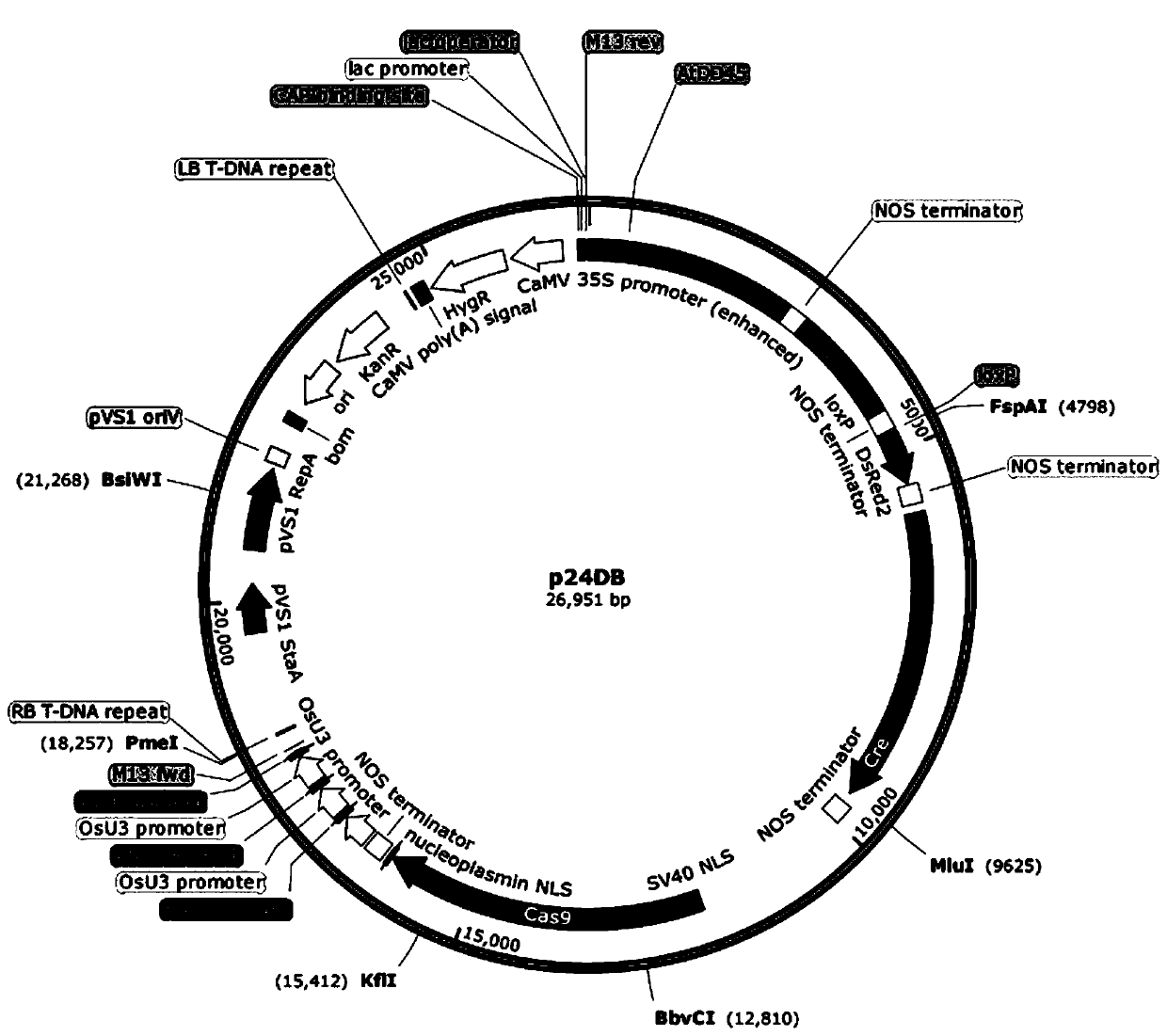A Seed Sorting Method for Fixed Plant Heterosis
A hybrid vigor and seed technology, applied in the field of plant molecular biology and agricultural biology, can solve the problems such as the inability to realize the application of the hybrid apomixis system, the inability to sort seeds, and the ratio of cloned seeds is not 100%. The effect of reducing complex seed production procedures, broad application and market prospects, and reducing production costs
- Summary
- Abstract
- Description
- Claims
- Application Information
AI Technical Summary
Problems solved by technology
Method used
Image
Examples
Embodiment 1
[0037] Construction of a rice expression vector carrying three linked gene expression cassettes: embryo autonomous gene E1, fluorescent selection marker gene E2, and regulatory selection marker gene expression cassette E3:
[0038] 1. Selection of specific promoters and target genes
[0039] Through literature review and web search, an oocyte-specific expression promoter was determined AtDD45Pro , whose nucleotide sequence is shown in SEQ ID NO.1; determine an embryogenesis gene BBM1 , whose nucleotide sequence is shown in SEQ ID NO.2; an embryo-specific expression promoter was determined OsESP1 , its nucleotide sequence is shown in SEQ ID NO.3; the red fluorescent gene RP is determined to be a screening marker gene, and its nucleotide sequence is shown in SEQ ID NO.4; a pollen-specific expression promoter is determined, and its nucleotide sequence is shown in SEQ ID NO.5.
[0040] 2. Construction of apomixis vector p24DB
[0041] Respectively PAIR1 , REC8 , OSD1 D...
Embodiment 2
[0058] Obtaining transgenic plants:
[0059] Selection of rice expression vectors p24DB After a single colony of Agrobacterium was inoculated on LB medium containing 50 mg / L kanamycin and cultured in the dark at 26°C for 2 days, the Agrobacterium cells were washed with NB-AS liquid medium, and cultured with shaking at 180 rpm at 28°C for 90-120 min. Adjust the colony concentration to OD600 of 0.8-1.0, transform hybrid rice, sterilize the hybrid rice seeds, select the seeds with plump grains, soak in 75% alcohol for 30 s, pour off the alcohol, rinse with sterile water, and rinse with HgCl 2 Disinfect for 8 minutes, wash with sterile water twice, soak for 1 minute each time, and soak in sterile water for 1 hour. The sterilized seeds were inoculated on the induction medium and grown under light for 7 days.
[0060] Pool the sterile callus together. Put it into the Agrobacterium suspension, soak for 5-10 min, take it out, and dry it with filter paper. Inoculate into the co-cu...
Embodiment 3
[0063] Molecular testing of transgenic plants:
[0064] DNA extraction: Take 1.0 g leaves, grind them into powder with liquid nitrogen, transfer them to 2 ml EP tubes, and add 700 μl preheated CTAB solution. Place in a water bath at 65°C for 30-60 min, mix gently during the period, add an equal volume of chloroform:isoamyl alcohol (24:1) after cooling, mix well, centrifuge at 12000 rpm for 10 min, take the supernatant into a new centrifuge tube, Add 500 μl of isopropanol and let stand at -20°C for 30-60min. 4°C, 12000 rpm, 10 min to collect the precipitate, discard the supernatant. Wash the precipitate twice with 70% ethanol, dry the alcohol residue, 50-100 μl ddH 2 O dissolved the precipitate and set aside.
[0065] PCR analysis: with RP The gene was used as a template to design primers, and the amplified product fragment was 431 bp.
[0066] Forward primer:
[0067] F: 5' CCCAGTTCCAGTACGGCTCCAAG 3';
[0068] Reverse primer:
[0069] R: 5'CTCGTTGTGGGAGGTGATGTCCAG 3'....
PUM
 Login to View More
Login to View More Abstract
Description
Claims
Application Information
 Login to View More
Login to View More - R&D Engineer
- R&D Manager
- IP Professional
- Industry Leading Data Capabilities
- Powerful AI technology
- Patent DNA Extraction
Browse by: Latest US Patents, China's latest patents, Technical Efficacy Thesaurus, Application Domain, Technology Topic, Popular Technical Reports.
© 2024 PatSnap. All rights reserved.Legal|Privacy policy|Modern Slavery Act Transparency Statement|Sitemap|About US| Contact US: help@patsnap.com








